I enjoy a good adventure, especially an adventure in the kitchen.
It keeps things exciting. Fresh. Entertaining.
Mind you, some of these ‘adventures' turn out to be a horrible recipe or small kitchen fire, but an adventure they are none-the-less!
My friends, today we are venturing into one of these adventures. Its one of those times where we let go of all abandon and throw ourselves into a delightful recipe that we might otherwise have avoided.
Is it something new? Yes.
Is it out of our comfort zone? Perhaps.
Is it full of probiotic, lacto-fermented goodness? You know it!
So strap on your big-girl-pants and here we go – Lacto-fermented Fruit Kvass.
‘Kvass' is actually a Russian word that refers to a fermented grain & sweetener of some sort (think beer…), but regardless, ‘kvass' is what we will call it. And no, there is no alcohol in it.
You will need:
– 1 core fruit (ie: pear, apple, etc.) sliced
– A handful of berries (blueberries, raspberries, strawberries) – and yes, you can use store-bought frozen ones! I used blueberries from our neighbors patch that I had previously frozen.
– 1 tablespoon of grated ginger (optional)
– 1/2 cup raw milk whey (remember this recipe?) If you don't want to make your own, check out your local health food store.
– Filtered water
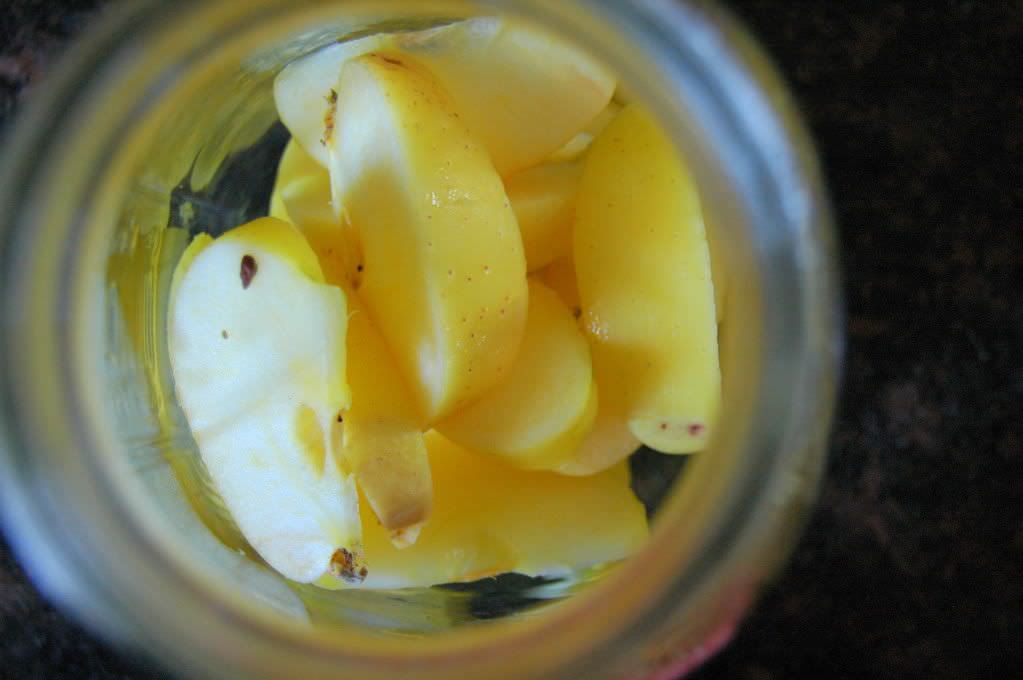
Step One: Slice the core fruit and place in a quart size mason jar. Add in the berries & ginger.
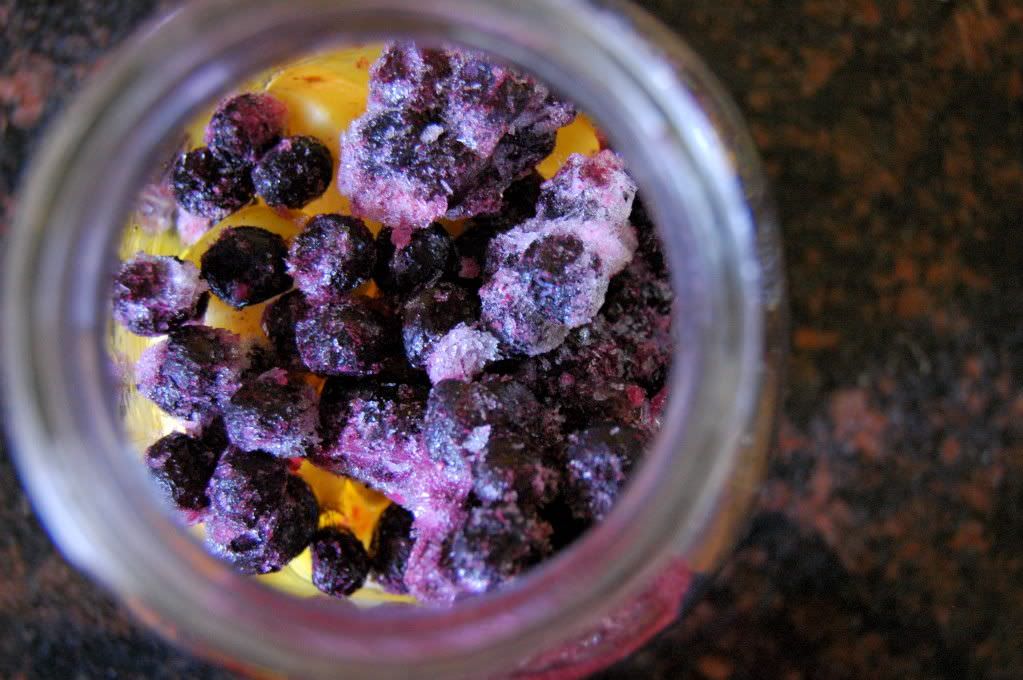
Step Two: Pour the whey over the fruit.
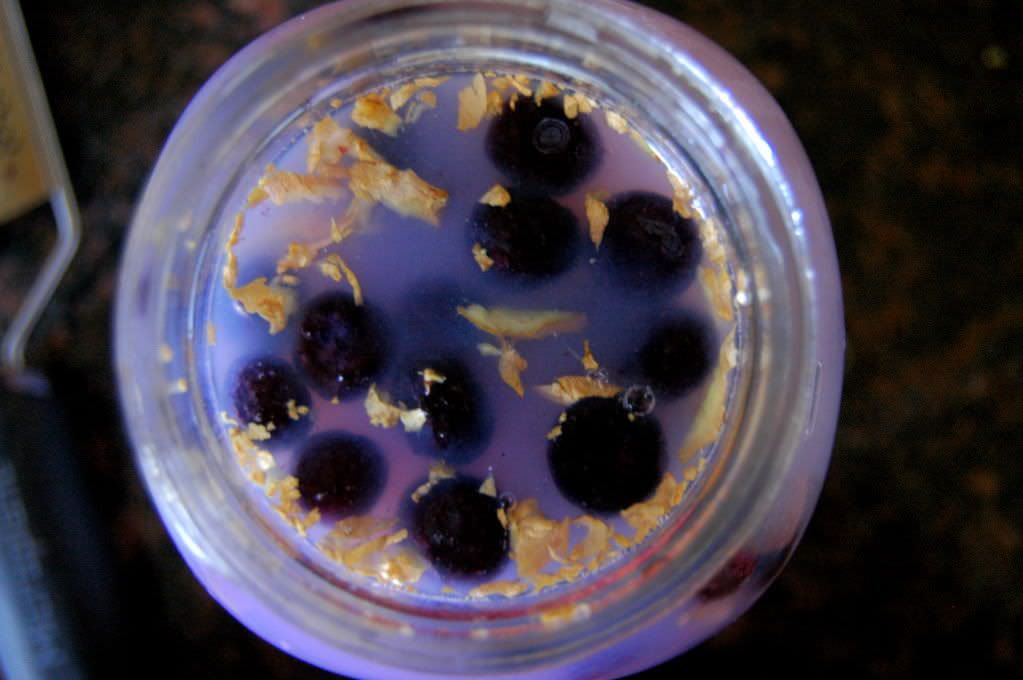
Step Three: Top the jar off with filtered water.
Step Four: Place a loose plastic bag over the mouth of the jar and then, insert a pint sized jar into the quart jar opening. It's very important with lacto-fermenting that the fermenting fruit is completely submerged under the liquid. The pint sized jar is just the right size for submerging the fruit and making sure that air doesn't get into the jar, but just to be safe, let's rubberband the plastic bag around the large jar to ensure a nice & sealed vessel. There are a variety of creative ways that lacto-fermenters have learned to keep their fruit submerged and jars sealed, and by all means, get creative and find what works for you.
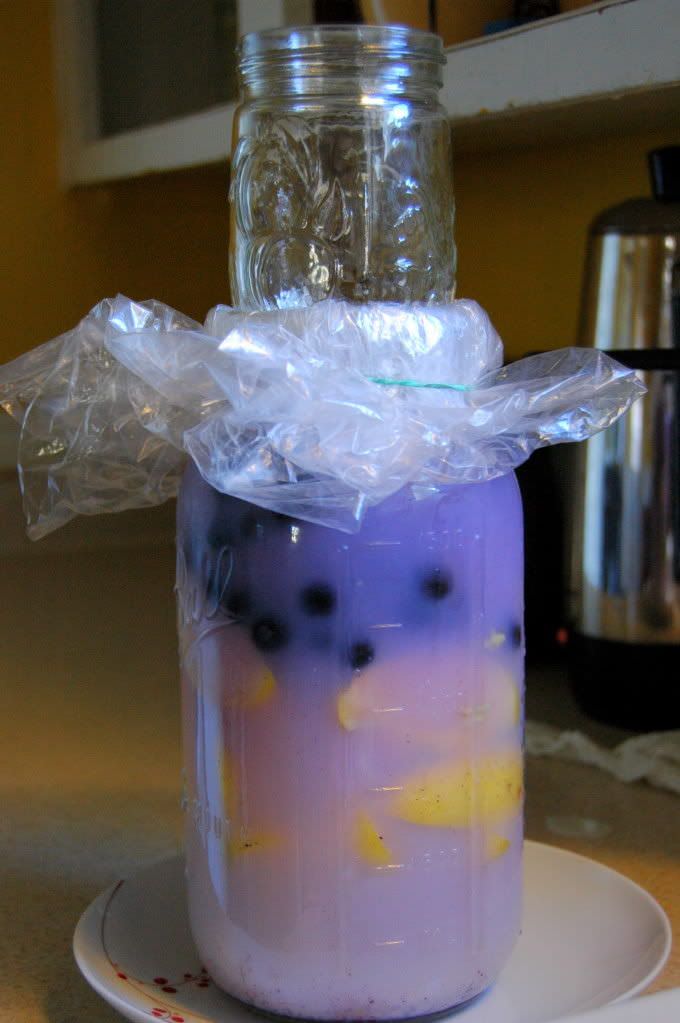
Step Five: Allow the jar to remain at room temperature for three days. During this period, the whey will begin the fermentation process. Healthy bacteria and probiotics will grow and flourish! I know, that's a hard one for people to get over. We tend to think of bacteria as a bad thing…but just think about how socially acceptable yogurt is! Same thing, different application.
Step Six: After the fermentation period is over, strain away the leftover fruit and store the jar in the fridge. As much as I hoped to have a completed photo of this lacto-fermented goodness, well…that just didn't happen. Forgive me.
Lacto-fermented fruit juice, or fruit kvass, is a wonderful treat for the kiddos. Not only is it a special treat (as juice normally is), but this juice feeds their little guts with wonderful goodness. As Sally Fallon points out:
The proliferation of lactobacilli in fermented vegetables enhances their digestibility and increases vitamin levels. These beneficial organisms produce numerous helpful enzymes as well as antibiotic and anti carcinogenic substances. Their main by-product, lactic acid, not only keeps vegetables and fruits in a state of perfect preservation but also promotes the growth of healthy flora throughout the intestine.
And so there it is. A wonderful, inexpensive, delicious alternative to store-bought juice and soda. If you'd like to read a bit more on the benefits of lacto-fermentation and why we are continually incorporating more of them into our diet, HERE is a great article.
I like to dream of a time when people are enthusiastic about putting goodness into their body. A time when people get excited about the proliferation of lactobacilli and lactic acid. A time when Pepsi and Coca-Cola don't exist, but instead our children are downing kombucha, kefir, and fruit kvass.
Hey, a girl can dream, can't she?
For other great meal ideas, no matter what your dietary restrictions, check out the meal planning service I use: Real Plans.
Lacto-fermented Fruit Kvass
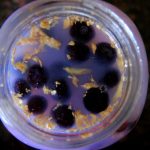
- 1 core fruit sliced ((ie: pear, apple, etc.))
- A handful of berries – and yes, you can use store-bought frozen ones! ((blueberries, raspberries, strawberries) I used blueberries from our neighbors patch that I had previously frozen.)
- 1 tbsp grated ginger (optional)
- ½ cup 1/2 cup raw milk whey (If you don't want to make your own, check out your local health food store.)
- Filtered water
Slice the core fruit and place in a quart size mason jar. Add in the berries & ginger.
Pour the whey over the fruit.
Top the jar off with filtered water.
Place a loose plastic bag over the mouth of the jar and then, insert a pint sized jar into the quart jar opening. It's very important with lacto-fermenting that the fermenting fruit is completely submerged under the liquid. The pint sized jar is just the right size for submerging the fruit and making sure that air doesn't get into the jar, but just to be safe, let's rubberband the plastic bag around the large jar to ensure a nice & sealed vessel. There are a variety of creative ways that lacto-fermenters have learned to keep their fruit submerged and jars sealed, and by all means, get creative and find what works for you.
Allow the jar to remain at room temperature for three days. During this period, the whey will begin the fermentation process. Healthy bacteria and probiotics will grow and flourish! I know, that's a hard one for people to get over. We tend to think of bacteria as a bad thing…but just think about how socially acceptable yogurt is! Same thing, different application.
After the fermentation period is over, strain away the leftover fruit and store the jar in the fridge. As much as I hoped to have a completed photo of this lacto-fermented goodness, well…that just didn't happen. Forgive me.

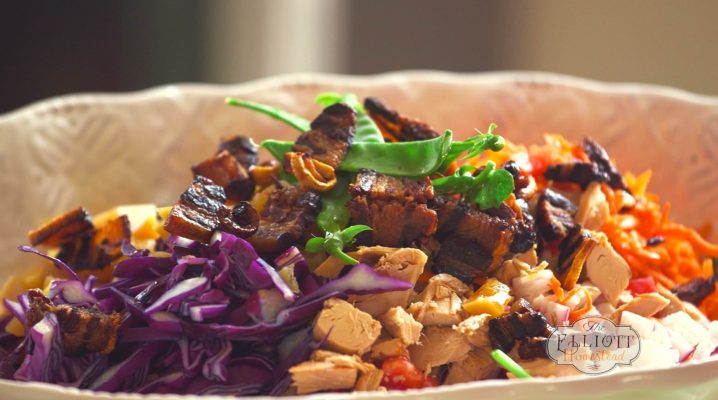
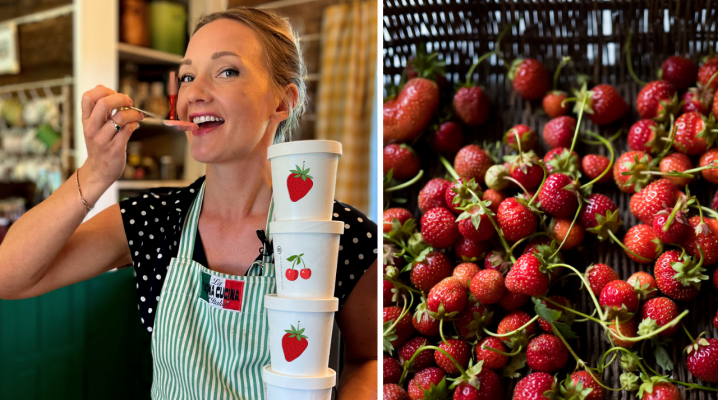
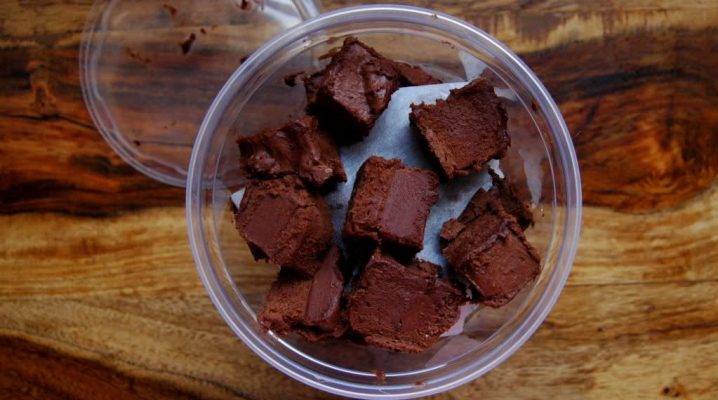

Oh Yes, Yes, Yes! I want this in my belly! I am not the out-of-the-box thinker that you are and I would never have thought of this!!! I can’t wait to try this! Thank you!
The bigger question, how did it taste?
Thanks for linking your great post to FAT TUESDAY. This was very interesting! Hope to see you next week!
Be sure to visit RealFoodForager.com on Sunday for Sunday Snippets – your post from Fat Tuesday may be featured there!
http://realfoodforager.com/fat-tuesday-january-17-2012/
Share your great fermented food recipes at my Probiotic Food Linky – open through Februray 6, 2012.
http://realfoodforager.com/probiotic-food-challenge-linky/
I made this yesterday after seeing your post! What do you do with the strained fruit?
Kim, I compost mine! I’m sure if you have chickens, they’d love it!
This is awesome.
@Kim R, that was my first question, too! Is it still edible?
Also, when I make beet kvass I use the beets twice and then compost. Is fruit the same?
@Adrienne – I would say do not eat the fruit. Bleeeck! Mine is ready now so I tried a blueberry and it tasted like mushy carbonated grossness.
Too bad on the taste, Kim R. Wish we could get more input on this from the author!
I have a question about the whey – can I use whey that I made from pasturized, non-homogenized milk? Seems like I should be able to…. I do not have access to raw, but would love to reap at least some of the benefits from kvass.
Sure!
Do I need to defrost the berries or is frozen fine. In the picture your berries look frozen but I just want to be sure. TIA
I’ve used both fine!
Wondering if you could use it in smoothies and freeze into pops without killing the good flora?
You bet!
Can you keep some of the finished product for starter for the next batch, or do you always have to have the whey?
You can keep some as starter – great idea!
Just shared this in my new blog post “Thirsty Thursday”, I hope that you’ll swing by and check it out! I love following your blog and have enjoyed making the recipes for years now.
I don’t have access to raw milk because it’s illegal in NC. What can I use as a sub to make the whey?
Do you make kefir at home? I used whey strained from my kefir (which was made from pasteurized milk, but cultured by the kefir grains).
What would happen if I just put the mason jar lid on it?
I filled my container with the fruit, water, and whey mix, but I left an inch of air at the top of the container. Is that bad?
my container is sterilized and sealed
are you sure you used a quart size jar ? the picture looks like a half gallon, might want to specify.
Thanks,
Stephanie
I’ve made this a couple of times and loved it up through now. I had some jun tea and switchel in the fridge that I’m drinking too, so I had two bottles of fruit kvass that weren’t drank quickly. They fermented for three days and have been in the fridge for two and I’ve been trying to drink one today. It has turned very thick and is bubbling actively like a witches cauldron. It doesn’t taste great which is expected when all the sugar has been eaten by the bacteria, but it seems like it has over- fermented. Is this dangerous or unhealthy? Outside of me feeling like I’m one of macbeths witches, it’s scaring my coworkers.
How much carbonation ends up being in the end product? And what is your favorite flavored kvass to make? Thanks for sharing your recipe, can’t wait to make it at home!